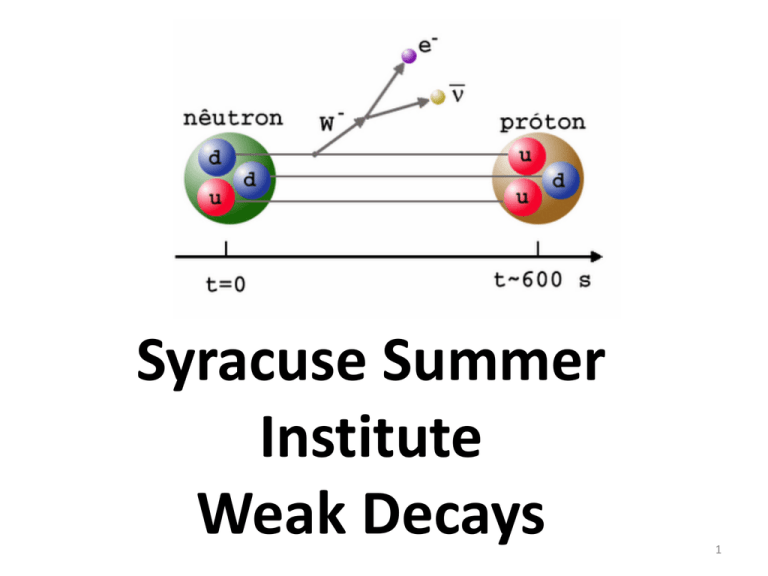ppt - HEP Educational Outreach
advertisement

Syracuse Summer Institute Weak Decays 1 Weak Interactions and Decays • It’s an experimental fact that particles decay. • The first place one usually encounters this is in the context of radioactive nuclei. • Why do some particles decay? … because they can? – Remember, in QM, unless something is strictly forbidden from happening, it will occur with some probability! 2 Examples of radioactive decay U 234 90 4 2 Rn 218 84 Po He 238 92 222 86 Th He 4 2 C N e ( ) 14 6 40 19 14 7 40 20 K Ca e ( ) Co Co 60 27 60 27 3 Radioactivity • Some nuclei spontaneously disintegrate. – Heavy nuclei decay down to lighter ones – Other way violates energy conservation! • Three main forms of radiation from nuclei: – Alpha (a): 2p+2n = He nucleus (very stable structure) • Change of element – Beta (b) : electrons, n p + e- + • Change of element – Gamma (): a high energy photon, ~10’s of MeV • Often referred to as “gamma rays” • Same element – Beta+ (b+): p n + e+ + (Can only happen in a nucleus) • Why? – By doing so, the system goes to a lower energy state. This is what nature likes to do… 4 Nuclear Stability Not all nuclei are stable Stable nucleus Unstable nucleus At Z=40, N/Z ~ 1.2 At Z=80 N/Z ~ 1.5 As Z increases, more neutrons are needed per proton to obtain a stable nucleus? Why’s that? Once Z>83, no longer have ANY stable nuclei ? 5 Time constant or lifetime For radioactive particles, it is found that the number that decay is proportional to the number you have: dN kN then, with a lil’ ole calculus: N N 0e t /t ( here k = 1/t ) t is called the lifetime or decay constant. It can be viewed as either: (a) time for N to decrease to (1/e)xN = 0.37N (time constant) (b) Average decay time <t> from a collection of radioactive decays (lifetime) 6 Let’s focus on “beta” decay C N e ( ) 14 6 40 19 14 7 40 20 K Ca e ( ) The underlying process is: n p e e Since M(n) = 939.56 MeV M(p) = 938.27 MeV/c2, M(e) = 0.51 MeV/c2 M(n) > M(p) + M(e), not forbidden by energy conservation, but very close! Free neutron lifetime ~882 sec (~15 min) VERY, VERY LONG ! HW: Why don’t neutrons decay when harbored in stable nuclei? Why don’t protons decay? 7 The Weak Force • So far, we’ve encountered: – EM force: Responsible for all of chemistry, atomic binding, etc – Strong force: responsible for nuclear binding, quark-quark interactions, etc. • We now encounter the Weak Force – Can lead to a change in quark type and charge (W±). – There are also weak interactions that don’t change quark type or charge (Z0) – Neutrinos only “feel” the weak force. – The force carriers of the weak force have LARGE mass • W±-boson: 80,000 MeV/c2 • Z0 boson: ~91,000 MeV/c2. • “Boson” refers to particles that have integral spin (here, Spin = 1). – The “charge” of the weak force is called “weak charge” – Both quarks & leptons carry weak charge! 8 Decays, in general • In general, unstable particles will decay in any way that they are able to. • In principle, particles can decay via the weak, EM or strong interaction. • If all are accessible, the preference is: 1) 2) 3) • • • Strong Electromagnetic Weak This is because the strong force has the largest strength (coupling constant). Particles generally only decay weakly if they cannot decay via the strong or EM interaction. In some cases, particles can decay via more than one of the forces. E.g Decay of excited D0 (cu) meson D*0 D0p0 (62%, strong) D*0D0 (38%, EM) 9 Digression on range of forces 10 Virtual photons Quantum physics does not inhibit, say an electron, from emitting and re-absorbing a photon. This will violate energy conservation But, as long as the “transit time” and energy of the photon satisfy: DEDt ≥ , It’s OK! Large Dt Photon will have smaller energy e Small Dt Photon can have large energy Because the photons at large distance carry smaller and smaller energy (& momentum) this accounts for the 1/r2 falloff of the EM force!e 11 An even more complicated picture A charged particle is continually emitting and re-absorbing photons +Q Real photons have zero mass These photons generally won’t have mass=0. Called virtual photons. The neat thing about virtual particles (in general) is that since they are emitted and re-absorbed, its mass is not limited by energy conservation!!! 12 It can get even more complicated Nothing prohibits a virtual photon from “transforming” into mass in the form of an e+e- pair. +Q e- e+ The effects of these virtual quantum loops are an integral part of QM. If you don’t include them, QED would disagree with experimental data ! If you include them, you get the right answer 13 The ± W Boson • The W boson is has very large mass (~90mp). From the uncertainty principle: Dt / DE / mW c d ~ cDt / mW c 2 Very short range … ~ 0.001 of the proton radius • Also, the W boson decays. Because both leptons and quarks have weak charge you can get: W- e- , m - , t e , m , t W- q Primarily ud , us q cd , cs 14 Ok, now on to beta decay n p e e e- e W- u u d d u d Here , the d-quark emits a W- and transforms into a u quark. Easy to see that charge is conserved throughout. The ud “just goes along for the ride” (spectator quarks) The underlying quark-level process is: d u W u e e Many weak decay diagrams look very similar to this ! 15 Let’s look at a B meson decay B D e e 0 B- e- e W- c b D0 Here, the underlying quark-level process is: b c e e Particles containing b-quarks have relatively long lifetimes of ~1.5x10-12 s. This may not seem long, but: dist vt 2 using E lab B = mB c : 2 =E lab B /mB c 100 GeV / 5 GeV 20 Since v c dist = 20 (3x108 m / s )(1.5 x1012 s ) = 9 mm These distances are measureable with modern detectors. 16 Not quite the whole story … e- e W- d W+ c b B- D0 B D e e u 0 s D K p 0 p+ K- The D0 particle is unstable as well. It has t ≈ 0.4x10-12 s. So, it travels (on average) about 3 mm before decaying. The K- and p+ have lifetimes ~104 times larger, so they mostly traverse the detectors and are detected before they decay! 17 So, the weak decay looks like B D e e 0 D K p 0 e eK- B- D0 p+ B- produced here, say in pp collision B- decayed here. D0 ,e-, e produced here. D0 decayed here. K-, p produced here. 18







